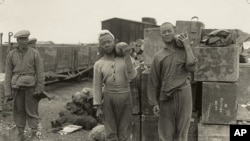World War I drew in people from around the world, including 140,000 Chinese workers who served on the Western Front. A new museum exhibition in Flanders, Belgium, highlights China's role in the war. It appears the curators have had to cancel plans to take it to China.
The little known story of the 140,000 Chinese who served on the Western Front during WW I has drawn new interest in recent years.
The Toiling for War exhibition at the In Flanders Fields Museum in Ypres, Belgium, is the first to detail the pivotal Chinese involvement in the conflict.
Forgotten story
Dominiek Dendooven is the assistant curator and researcher at the museum. He helped put together the exhibition and says it is time for the world to recognize China's war effort - and how the conflict has shaped modern China.
"For decades the story of the Chinese labor cause was entirely forgotten," he said. "But in the last decade, the last five years actually, you see that all over the world people are getting an interest in it, this common history that we share."
The Chinese laborers buried the dead, dug trenches, worked in munitions factories and cleaned up the shells, grenades and bullets after the November 11, 1918 armistice.
One hundred thousand served in the British Chinese Labor Corps between 1917 and 1919, and each received a medal for his service. About 40,000 others served with the French forces, and hundreds of Chinese students served as translators.
Plan A
Originally, the Ypres museum planned to take the exhibition to China in November for five months. But Dendooven says Chinese officials did not guarantee that the exhibition would not be altered, so tour is to be canceled.
"We know the context of the story. So as just to keep the history coherent, it is one of our wishes that we have a say in how the exhibition will be organized in China," he explained.
One historical controversy is the number who died in the war. Some Chinese scholars say the number was as high as 20,000. But records kept by the British and French recruiters show just under 2,000 lost their lives, many from the flu pandemic that swept the world starting in 1919.
Many historians and academics say China's role prevented a German victory, such was the allies' manpower shortage toward the end of the war.
Costly sacrifice
For the laborers, the war was a way to make far more money than they could at home. But their sacrifice became a pivotal point in Chinese history.
After the armistice, the 1919 Treaty of Versailles saw Germany's concession ports in China handed to Japan, despite China's objections. Unhappiness over the treaty led to the May 4 protest movement, which is seen as contributing to the eventual rise of the Communist Party, which has ruled China since 1949.
Years of internal bloodshed, invasion, civil war and revolution all have close links to WW I and the resulting peace treaties.
Brilliant strategy
Xu Guoqi is a professor of history at the University of Hong Kong. His book, Strangers on the Western Front: Chinese Workers in the Great War, will be published this year. He says that sending as Chinese laborers to the front was a brilliant strategy to link China with the West.
And he underscores the link between the war and the founding of China's Communist Party. During the war, the young interpreters drew up education plans in spare moments away from the dangerous toil on the battlefields. As a result nearly two-thirds of the laborers returned home able to read. He says that effort inspired the men who went on to lead the Communist Party.
"The book status group of Zhou Enlai and Deng Xiopang and many others got involved. We literally followed the footprint of Chinese workers in Europe during the first World War," he said. "In other words, the Communist party of Deng Xiaoping and Chou En Lai and many others who became the work study students of that time, they played a very important role in Communist China. But we literally followed the footprint of this group. Mao Zedong himself payed attention to this group."
The exhibition also addresses the way the Chinese were treated once the guns fell silent.
The laborers were made scapegoats by Belgian refugees returning to their shattered homes. The Belgian government soon ordered the Chinese out of country.
Many of the Chinese laborers were recruited from the British and French concession ports in Shandong Province.
Rediscovering history
Researcher Zhang Yan from Shandong University in Weihai has been commissioned to locate relatives of those who served on the Western Front to help China rediscover an important part of its history.
He will accompany some of the relatives at a special ceremony in The Belgium Pavilion at the Shanghai Expo on Friday, September 24.
In May, he traveled to Flanders and the Western Front.
During the Last Post Ceremony at the Menin Gate memorial to the allied war dead, he read out the names of 13 Chinese killed during a German air raid in 1918.
Zhang says the trip to Europe was very moving for him.
He says to pay respect to the Chinese dead and to let their descendants know of their relatives' fate is an important way for the Chinese to find out more about their WW I history and how it has shaped modern China.







